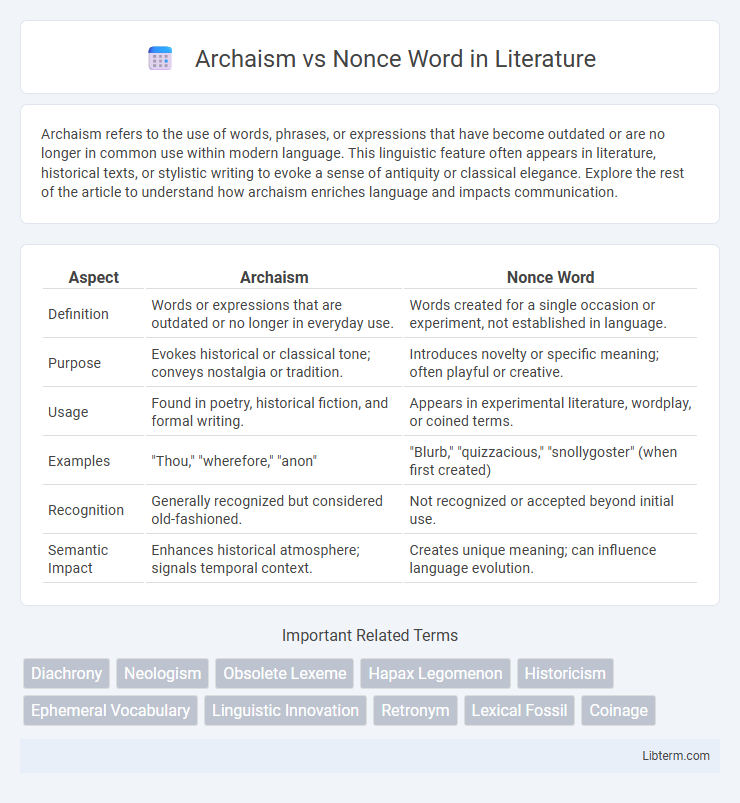Archaism refers to the use of words, phrases, or expressions that have become outdated or are no longer in common use within modern language. This linguistic feature often appears in literature, historical texts, or stylistic writing to evoke a sense of antiquity or classical elegance. Explore the rest of the article to understand how archaism enriches language and impacts communication.
Table of Comparison
| Aspect | Archaism | Nonce Word |
|---|---|---|
| Definition | Words or expressions that are outdated or no longer in everyday use. | Words created for a single occasion or experiment, not established in language. |
| Purpose | Evokes historical or classical tone; conveys nostalgia or tradition. | Introduces novelty or specific meaning; often playful or creative. |
| Usage | Found in poetry, historical fiction, and formal writing. | Appears in experimental literature, wordplay, or coined terms. |
| Examples | "Thou," "wherefore," "anon" | "Blurb," "quizzacious," "snollygoster" (when first created) |
| Recognition | Generally recognized but considered old-fashioned. | Not recognized or accepted beyond initial use. |
| Semantic Impact | Enhances historical atmosphere; signals temporal context. | Creates unique meaning; can influence language evolution. |
Understanding Archaism: Definition and Examples
Archaism refers to words or expressions that have fallen out of everyday use but remain recognizable due to their presence in historical texts or literature, such as "thou" or "hither." These terms often evoke a sense of antiquity or formality, providing stylistic or historical context in writing. Understanding archaism involves recognizing how these outdated words contrast with modern language while enriching linguistic diversity and cultural heritage.
What is a Nonce Word? A Brief Overview
A nonce word is a linguistic creation invented for a specific occasion or context, often without intention of permanent use. Unlike archaisms, which are outdated words preserved from older language forms, nonce words serve immediate communicative or creative needs, such as in poetry or humor. These words demonstrate language's adaptability by filling lexical gaps or conveying novel concepts temporarily.
Key Differences Between Archaisms and Nonce Words
Archaisms are words or phrases that were commonly used in the past but have fallen out of everyday use, often preserved in literature or historical contexts. Nonce words are newly coined terms created for a specific occasion or purpose and typically have limited usage beyond that context. The key difference lies in archaisms representing historical language with established past usage, while nonce words are innovative and ephemeral linguistic creations.
Linguistic Roots of Archaisms and Nonce Words
Archaisms derive from historical linguistic roots, reflecting older forms, usages, or meanings that have faded from everyday language but remain embedded in cultural and literary contexts. Nonce words emerge spontaneously to fill immediate communicative needs or creative expressions, often lacking established etymological backgrounds yet showcasing linguistic innovation. Understanding the linguistic roots of archaisms involves tracing phonological, morphological, and semantic shifts over time, whereas nonce words highlight language's dynamic adaptability and real-time formation.
Usage Scenarios: When Are Archaisms Used?
Archaisms are primarily used in literature, historical texts, and poetic works to evoke a sense of antiquity or authenticity, often enhancing atmosphere and character voice. They appear in legal and religious documents to maintain tradition and authority, preserving the original phrasing that conveys specific cultural meanings. Unlike nonce words, which are created for immediate, context-specific use, archaisms serve to connect modern language with its historical roots, reinforcing continuity in language and culture.
Creative Applications: The Role of Nonce Words
Nonce words serve a crucial role in creative applications by enabling writers and speakers to innovate language for specific contexts, often filling lexical gaps that archaisms cannot address due to their outdated usage. These ephemeral, context-driven creations can evoke novelty, humor, or emphasis, proving especially useful in poetry, advertising, and storytelling. While archaisms carry historical and cultural weight, nonce words provide dynamic flexibility that caters to immediate expressive needs and imaginative exploration.
Archaisms in Literature and Historical Texts
Archaisms in literature and historical texts serve as linguistic markers that evoke a specific historical period or cultural atmosphere, enriching the reader's experience by maintaining authentic dialogue or narrative voice. These obsolete or antiquated words often appear in classical works and historical documents, preserving the original tone and style while highlighting the evolution of language over time. The deliberate use of archaisms helps scholars analyze societal norms, values, and language usage from past centuries, providing invaluable insights into historical contexts and literary traditions.
Nonce Words in Modern Media and Technology
Nonce words, often created spontaneously for a specific occasion, are increasingly prevalent in modern media and technology, reflecting rapid cultural and technological changes. Terms like "blogosphere" and "selfie" emerged as nonce words that quickly entered mainstream language due to their relevance in digital communication and social media platforms. The fluidity and innovation of nonce words enhance linguistic adaptability, enabling precise expression of new concepts in an evolving technological landscape.
Impact on Language Evolution: Archaisms vs Nonce Words
Archaisms preserve the historical layers of language, offering insight into past linguistic structures and cultural contexts, which helps linguists trace the evolution of vocabulary and grammar. Nonce words, created spontaneously for specific occasions, contribute to language innovation by filling lexical gaps and often influencing future word formation if they gain popularity. The interplay between archaisms and nonce words drives language evolution by balancing tradition with creativity, ensuring both continuity and dynamism in linguistic development.
Choosing the Right Term: Practical Tips for Writers
Selecting between archaism and nonce words requires writers to consider context, audience, and clarity. Archaisms evoke a historical or classical tone, enriching narrative depth when used appropriately, while nonce words offer creativity and uniqueness tailored to specific situations. Practical tips include assessing the text's purpose, avoiding confusion, and balancing familiarity with originality to enhance reader engagement.
Archaism Infographic

 libterm.com
libterm.com